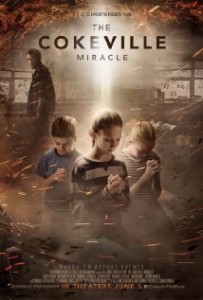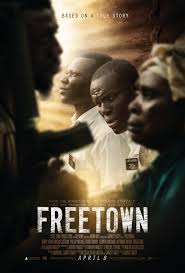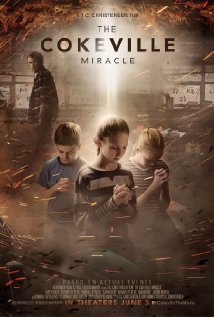 This episode features a fantastic conversation on film and the many roles it plays in human lives and communities, especially religious ones. Along the way it wrestles with the tensions that are always present in films for niche audiences, especially when filmmakers try to tell compelling stories while at the same time hoping to make money, which often means making many decisions based upon their sense of what their target audience expects (and, in so doing, sometimes lessening a story’s potential impact). How does this environment of tension between art and commerce hinder (or help) foster great storytelling and a film’s ability to rise to a high artistic level? Are there lenses (other than “Is it ‘great art’?”) that we should use in judging a film’s merits?
This episode features a fantastic conversation on film and the many roles it plays in human lives and communities, especially religious ones. Along the way it wrestles with the tensions that are always present in films for niche audiences, especially when filmmakers try to tell compelling stories while at the same time hoping to make money, which often means making many decisions based upon their sense of what their target audience expects (and, in so doing, sometimes lessening a story’s potential impact). How does this environment of tension between art and commerce hinder (or help) foster great storytelling and a film’s ability to rise to a high artistic level? Are there lenses (other than “Is it ‘great art’?”) that we should use in judging a film’s merits?
 Panelists Arthur Van Wagenen, head of Excel Entertainment (Deseret Book’s film arm), Sterling Van Wagenen, co-founder of the Sundance Film Festival and the Sundance Institute, filmmaker, teacher, and former administrator in several LDS film and television organizations, and Stephen Carter, writer, editor, filmmaker, and insightful commentator on the role of storytelling in our lives, join Mormon Matters host Dan Wotherspoon for a wonderful, far-ranging discussion about these and other questions. What are the various entities that create or distribute films and visual media content under the auspices of the LDS Church? What are their missions and commissions (the parameters set forth for their work)? Going forward, can we expect similar films and projects to what we’ve seen in the past? What criteria are Excel using as it seeks new projects and works with the films it distributes? What are the roles that film play in communities large and small? What are the panelists’ favorite religious-themed films—especially ones that that might serve as models for LDS filmmakers?
Panelists Arthur Van Wagenen, head of Excel Entertainment (Deseret Book’s film arm), Sterling Van Wagenen, co-founder of the Sundance Film Festival and the Sundance Institute, filmmaker, teacher, and former administrator in several LDS film and television organizations, and Stephen Carter, writer, editor, filmmaker, and insightful commentator on the role of storytelling in our lives, join Mormon Matters host Dan Wotherspoon for a wonderful, far-ranging discussion about these and other questions. What are the various entities that create or distribute films and visual media content under the auspices of the LDS Church? What are their missions and commissions (the parameters set forth for their work)? Going forward, can we expect similar films and projects to what we’ve seen in the past? What criteria are Excel using as it seeks new projects and works with the films it distributes? What are the roles that film play in communities large and small? What are the panelists’ favorite religious-themed films—especially ones that that might serve as models for LDS filmmakers?
Please listen and then share your thoughts and comments below! And what are your favorite religious-themed films, or at least ones that led you to wonderful spiritual or life-changing reflections?


Comments 8
I thought that BYUTV’s Handel’s Messiah was moving, inspiring and a film I loved to watch more than once.
http://www.byutv.org/show/7e7b26be-527b-4113-af3c-04402eddae90/handels-messiah
I was hoping someone might have commented on it.
I just made the drive from San Juan Capistrano to Berkeley today and this podcast was first on the list! It was fantastic! Dan, I would love for you to post the personal lists of films that were mentioned at the end of the podcast. I have been deeply touched by many of those films, but I do not want to miss any that were highlighted for each of your guests. To Sterling and Arthur, I so enjoyed your hopefulness about the future of devotional/Christian film. And to Stephen, well, the only part that would have made the conversation better would have been if you had been in the car with me so we could have continued talking about Narratives!!!
Thanks again Dan.
What a tremendous episode. I had to write down all of the recommended films at the end of the episode and I made a Letterboxd list: http://letterboxd.com/derrific/list/spiritual-films/
I would add Scorsese’s Last Temptation of Christ, as well as a small film I came upon last year or so called Fill the Void. Love me some good spiritual films and I’ll be sharing this episode with my thoughtful filmgoing friends.
Pingback: Of Myth and Meaning | Reflections
Thanks to all four of you for the conversation. I’m glad we’re talking about Mormon films again now with all these new pictures coming out and underway. At the beginning of 2015 I counted around 27 feature-length films or web series (docs & narrative) with Mormon content that were either announced, in production, or done and ready to be released. A few have been cancelled or postponed and I’ve gotten word of a few more that I didn’t know about, so having around thirty full-length projects on the way bodes quite well for the community, besides shorts and television work. There were at least two films with Mormons in the last Tribeca Film Festival (including one produced by Manjula Varghese, who Arthur mentioned near the beginning), and Mormon-made films like Man from Reno and Peace Officer are really making the festival rounds. So, timely. Thanks.
If this is interesting to listeners, Katherine Morris on the Mormon Artist podcast interviewed Christian Vuissa a few months ago about the state and future of Mormon film. That’s here: http://mormonartist.net/podcast/episode-11-christian-vuissa/ And this will be the second year I’m working with Stephen and all the wonderful folks at Sunstone to bring films to the summer symposium, this year on the last day (Saturday) of the event. Those titles are probably not quite ready to be announced yet, but info will be on https://www.facebook.com/SunstoneFilm soon. Last year Sterling was on a panel about his film (produced) Faith of an Observer that was one of my favorite sessions, and this year’s films and conversations should be just as good.
Like Dan and Stephen I was gratified and surprised at the attitude in DMC to reach out to nontraditional Mormons. Perhaps our surprise is unfortunate, speaking to Deseret Book’s/Excel’s reputation for conservatism and risk aversion. Hopefully those assumptions will be proven increasingly wrong. As Arthur was talking about it, around the middle of your conversation, the thought that came to my mind was that if Excel wants to court that audience they’re going to have to take risks that I don’t really see them taking now. I haven’t seen any of the newest films, but The Cokeville Miracle, Once I Was a Beehive (although I LOVE that it’s about girls), and Just Let Go don’t look like boundary-pushing films: they all seem to be of the variety that you discussed that promotes existing faith, that builds up existing beliefs and social norms. That is great–as Terryl Givens said in his review of New York Doll, there is room for both–but if that remains the only type of film Excel releases then their audience will stay roughly stagnant and it will be up to another distributor(s) to reach out to less traditional Mormons who want to see their doubts and concerns given legitimacy and not dismissed or patly resolved by the end of a film.
I loved Sterling’s hope for a filmmaker or two with the skills and the probing of a Richard Dutcher. Probably we haven’t seen that person yet. Maybe it will be Garrett Batty, though his conclusions (judging just from Saratov) can be more simplistic than Richard’s, and of course Richard himself isn’t done having a conversation with Mormonism. So that’s a great aspiration, but what’s maybe disheartening for me is the iron-clad restriction that Excel has against R-rated films or films with any degree of violence, profanity, or sexuality–or unresolved religious doubt–in them. Obviously you don’t need all those elements in order to tell a spiritual story–most of the films you all mentioned near the end of the podcast demonstrated that brilliantly–but I think it’s a conversation to have about every film individually. When it’s an up-front policy, a precondition to even submitting a film for consideration, then it perpetuates a corporate image of a company that does not want to take risks or push boundaries or, hence, include “this” kind of Mormon story. Unfortunately, it doesn’t just become about the violence or sex or profanity, but about the questioning, the doubting, and the nonconformity itself. I don’t have a Deseret Book in my area, but my impression is that you can’t find The Backslider or anything by the Lost Generation or The Lonely Polygamist or A Song for Issy Bradley or even Eugene England on the shelves. And the same is true for most of the best Mormon films of recent years: things like Electrick Children, Falling, and Hawaiian Punch (though it’s relentlessly anti-commercial) wouldn’t be welcome in Deseret Book. These films’ makers, and probably many like them who are more believing of Mormonism’s essential truth claims, probably won’t even initiate the conversation with Excel for fear of censorship and disinterest.
My thought, while Arthur was talking about this, was: What if Excel did relax those standards slightly, assess films on a case-by-case basis, and make the decision to release, say, a film with roughly the same degree of “objectionable” material as States of Grace or Brigham City? What would the message be first to Mormon filmmakers who want to be that probing voice and, more importantly, to Mormon audiences? It could help change the culture, ever so slightly, to become more accepting of challenging films and books; Mormons could be more open to probing and questioning, more discerning of the difference between a sacrament meeting talk and a drama (which requires conflict); and those Mormons who are feeling pushed out by the culture or betrayed by learning genuine Church history after years of official whitewashing could see themselves on the screen. They could find some validation and inclusion in the community not just because they recognized themselves onscreen but because it was a Church-owned entity that provided that experience and that space for them. Some of these probing films will be like Babette’s Feast, rich and rewarding with nary a “heck” or a collarbone in sight, but some may be like The Decalogue, which essentially wouldn’t work at all if its protagonists didn’t essentially break each one of the ten commandments. And it’s in the probing and the breaking of the commandments that Kieslowski creates the space for yearning and faith and hope. Having Excel be the vehicle for that yearning and faith and hope for Mormons could do wonders for those struggling Saints. It could also increase DMC’s audience; given its association with the Church I don’t think it will lose many customers who find themselves offended by something on offer.
My point is that Excel may be the best poised entity out there to push our current resurgence of Mormon film to the next level. Because it is owned by the Church it can take risks. And it can do so by expanding its definition of what is acceptable within the Mormon community and what can be shown in Mormon art. Perhaps only a “classics” arthouse division with a different name could get approved by all the highest officials in DMC, but doing it under the Excel banner would have an even more profound effect. The sense that Mormon film is boxed into religious conservatism is stifling for many potential customers, even a great many with traditional beliefs and high Church activity. Having a Church-owned commercial film distribution entity push that boundary a little bit could do wonders. A film that doesn’t take risks is dead, and a film company that doesn’t take risks is also.
Mormon film has always tried to not offend and to build up faith and community in the Republic/propagandistic/devotional model you discussed. But in the age of the Internet, the Church history essays on lds.org, and mass disaffection, our films cry out for authenticity. The only way to reach that authenticity is to take risks, and the only way for Excel to take risks is to put out material that moves beyond their old standards of acceptability in favor of increased realism and greater authenticity for how Mormons in the real world look, behave, act, talk, question, and believe. It’s time for the cowboy Jesus to ride onto the screen.
That’s all for my pontificating from the sidelines. Thanks again for all the work that went into this episode!
Pingback: This Month in Mormon Literature, June 13, 2015 | Dawning of a Brighter Day
Pingback: LDS Church film entities: Sterling and Arthur Van Wagenen on Mormon Matters | Dawning of a Brighter Day